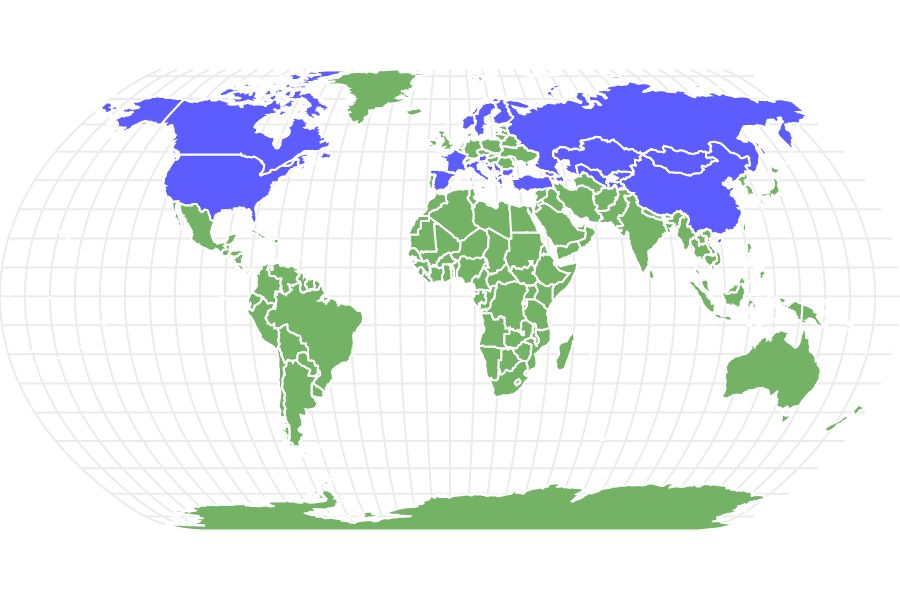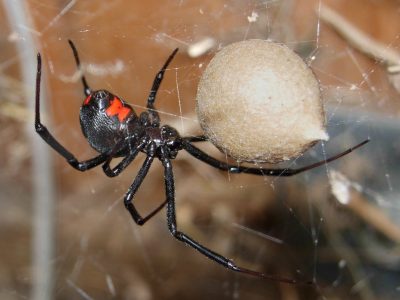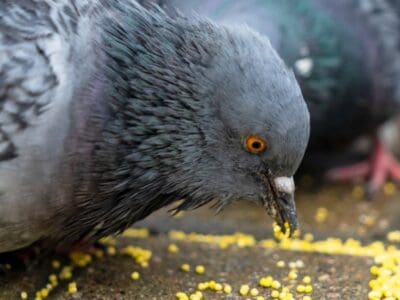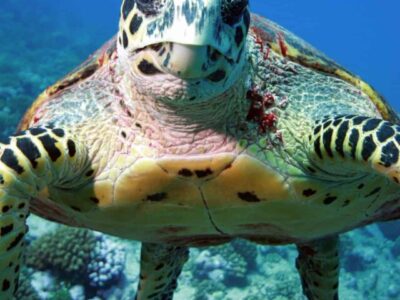Brown Bear
Ursus arctos
A dominant predator in it's environment!
Advertisement
Brown Bear Scientific Classification
- Kingdom
- Animalia
- Phylum
- Chordata
- Class
- Mammalia
- Order
- Carnivora
- Family
- Ursidae
- Genus
- Ursus
- Scientific Name
- Ursus arctos
Read our Complete Guide to Classification of Animals.
Brown Bear Conservation Status
Brown Bear Facts
- Main Prey
- Fish, Fruit, Insects
- Distinctive Feature
- Powerful forearms and hibernate in the winter
- Habitat
- Forest and mountainous regions
- Predators
- Human, Wolf, Cougar
- Diet
- Omnivore
- Average Litter Size
- 3
- Lifestyle
- Solitary
- Favorite Food
- Fish
- Type
- Mammal
- Slogan
- A dominant predator in it's environment!
View all of the Brown Bear images!
“Brown bears are often called “grizzly bears.”
Brown Bears are animals that are found in many parts of North America and Eurasia, where the bears inhabit wooded and mountainous areas. The brown bear is also the national animal of a number of states in North America, Europe, and Asia.
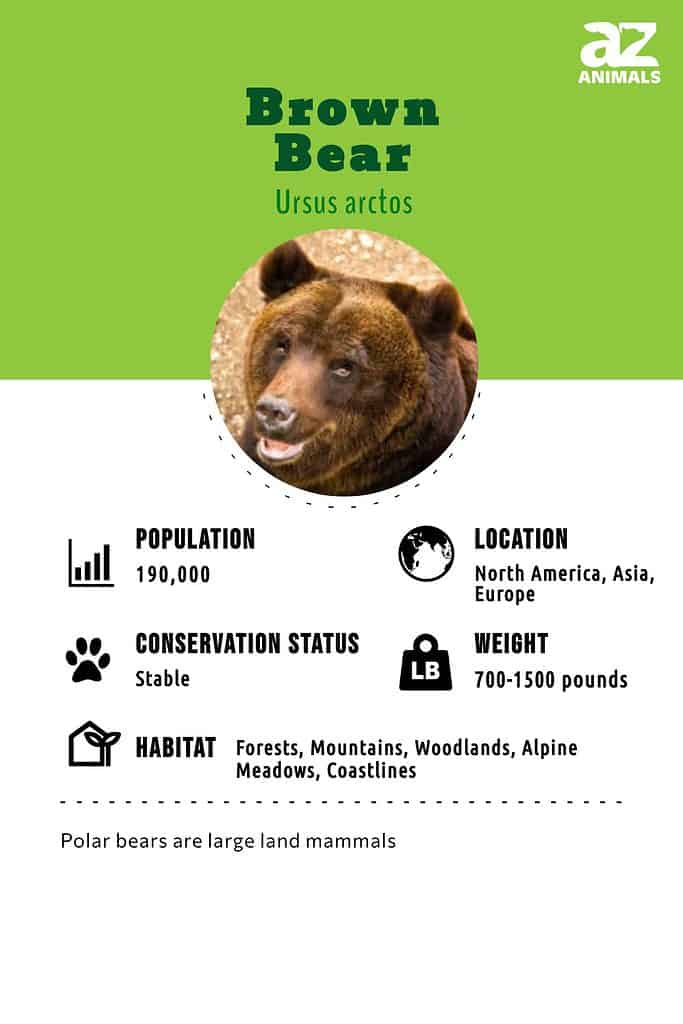
4 Amazing Brown Bear Facts
- The brown bear is the most widely distributed bear on the globe
- A group of brown bears is called a sloth or sleuth
- Before hibernation, the brown bear can eat up to 90 pounds of food a day
- It appears that brown bears have individual personalities and are extremely intelligent
You can check out more incredible facts about brown bears.
Scientific Name
The brown bear has the name of Ursus arctos and is a type of mammal. The name Ursus is derived from the Latin, which means “bear.” Both “ursus” and “arctos” mean bear, with “arctos” being the Greek term for this animal.
The term “Grizzly Bear” is called Ursus arctos horribilis. It is a subspecies of the brown bear and was named because the bear was somehow interpreted as “grisly or horrible” instead of the term for the coat being grizzled with streaks of gray.
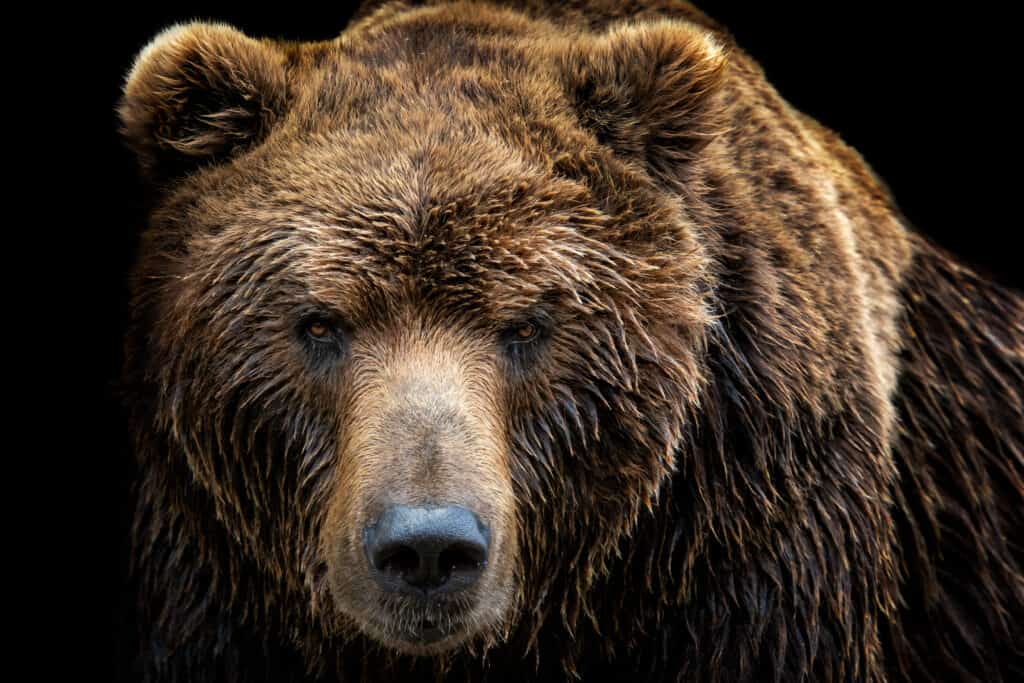
The brown bear has the name
Ursus arctos.
©Lubos Chlubny/Shutterstock.com
Evolution
Brown bears evolved from Ursus etruscus in Asia 800,000 years ago. Genetic analysis indicates they diverged from the cave bear complex 1.2-1.4 million years ago. Fossils of this species are found in China from 0.5 million years ago. It spread to Europe and North Africa 250,000 and Alaska 100,000 years ago before moving south 13,000 years ago when giant short-faced bears (Arctodus simus) went extinct.
Paleontologists suggest two migrations of brown bears: inland grizzlies from northern Siberia to central Alaska and Kodiak bears from Kamchatka to the Alaskan peninsula. Fossils in Labrador, Ohio, Kentucky, and Ontario show they once extended eastward.
Appearance and Behavior
Brown bears are extremely large animals. Brown bears can grow to be five to eight feet tall and weigh approximately 700 pounds. This means that the brown bear weight is about 75 percent as heavy as an Arabian horse, which weighs 930 pounds. Though some can be even larger. An Alaskan brown bear can weigh as much as 1500 pounds.
In the spring, after hibernation, a brown bear may weigh much less. To make up for this, the bear may eat as much as 90 pounds of food per day to gain weight for the coming winter and its hibernation.
They tend to be solitary animals; females and their brown bear cubs gather together and, at times, are known to congregate, especially at Alaska fishing spots. A group of bears is called a sloth or sleuth, but brown bears mostly live alone.
In winter, brown bears are animals that dig dens for hibernation, which are often found on hillsides.
Brown bears are very fast and are known to reach speeds of 30 to 40 miles per hour, as much as 30% faster than the top speed of the fastest human, Usain Bolt. If they are surprised or if a human gets between a mother and cubs, they can be dangerous. The brown bear is also known to be an exceptional swimmer.
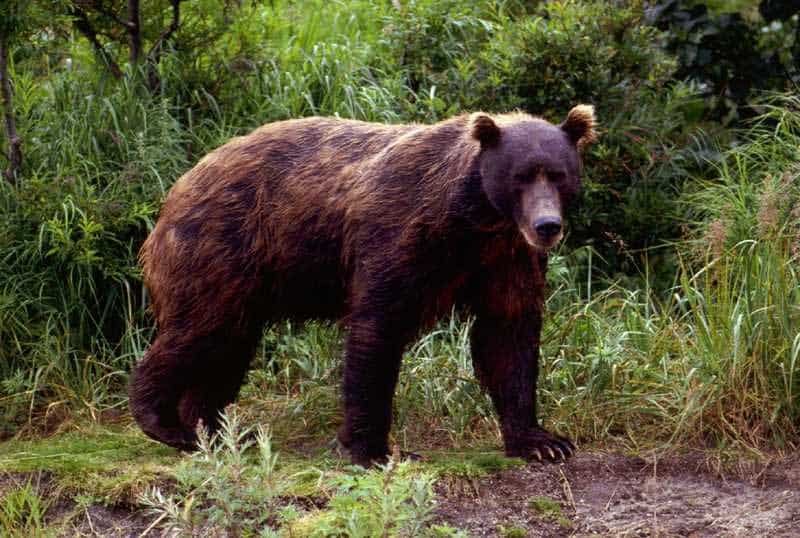
Habitat
Brown bears live in the forests and mountains of the northern parts of North America, Asia, and Europe. In Europe, they are found mostly in the woodlands of the mountains. Siberian brown bears prefer the forests, while in North America, they call the alpine meadows and coastlines home. Wherever they are, the brown bear prefers a habitat that has dense cover where they can feel safe and secure.
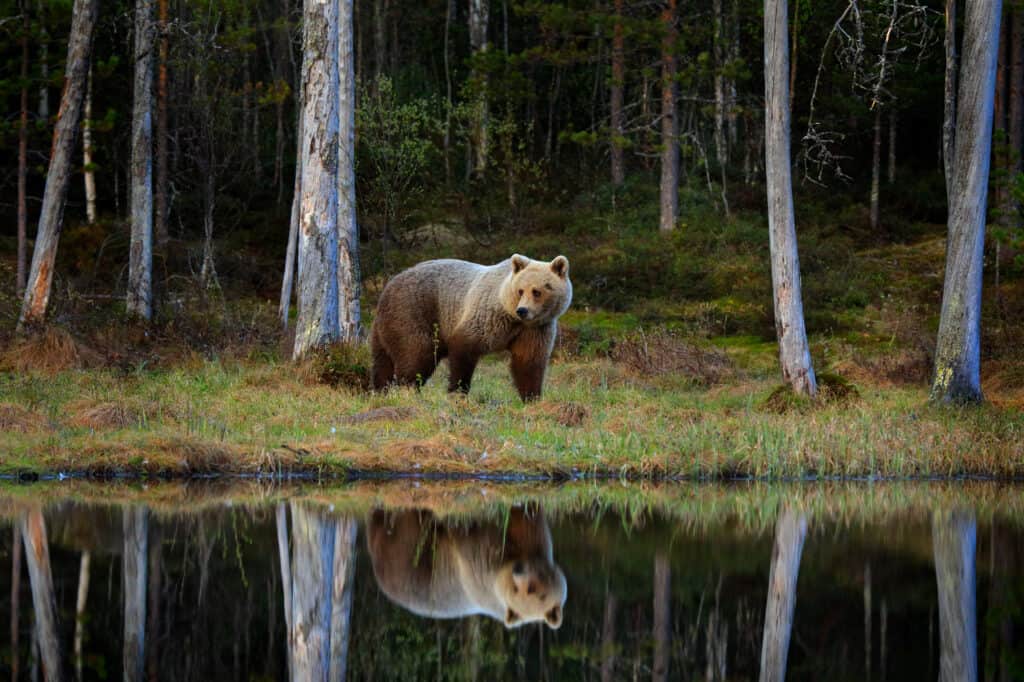
Brown bears live in the forests and mountains of the northern parts of North America, Asia, and Europe.
©Ondrej Prosicky/Shutterstock.com
Diet
Brown bears are omnivores. They are also top-of-the-food-chain predators. They eat other animals, such as rodents or moose. A large portion of their diet, however, consists of nuts, berries, fruit, leaves, and roots.
They also enjoy fishing for salmon and crave the fats that can take them through the long winter of hibernation. Before it hibernates, the brown bear has been known to eat as much as 90 pounds of food per day.
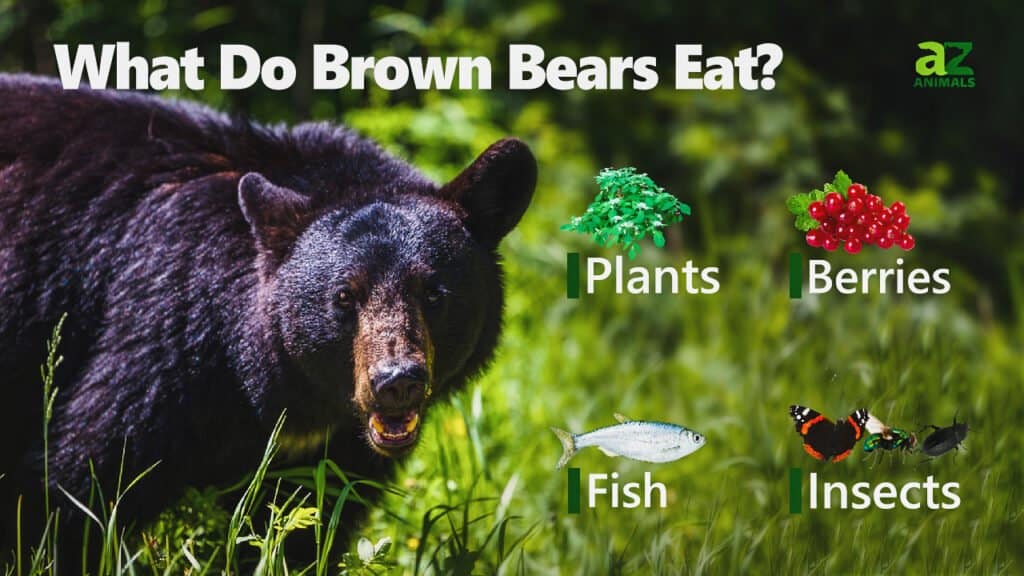
Predators and Threats
As one of the largest omnivores, the brown bear today does not have to worry about being eaten. They must worry about other brown bears. However, there are also other threats.
In the past, brown bears were threatened by big game hunters as trophies, and their hides and meats were used.
Poaching can be a problem. In Asia, some think that the bear gall bladder has medical benefits, although there is no evidence that this is true.
Logging, mining, and deforestation, as well as the destruction of habitat, threaten the brown bear population. The human-and-bear conflict has been an issue, as bears can interfere with roaming livestock, water supplies, fruit orchards, and trash bins.
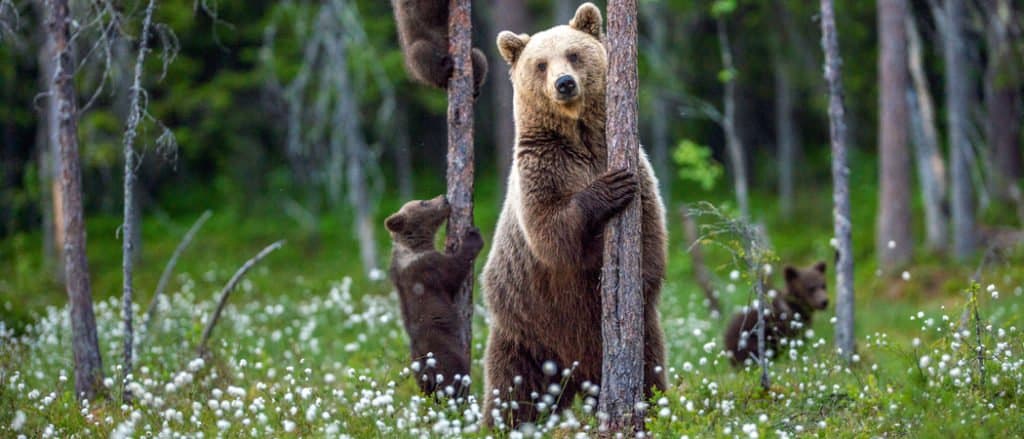
Logging, mining, and deforestation, as well as the destruction of habitat, threaten the brown bear population.
©iStock.com/USO
Reproduction, Babies, and Lifespan
Males may fight over females when mating and will guard the female for one to three weeks. They mate from May to July. Females go into the den while pregnant, then give birth during the winter rest, and usually have a pair of cubs. The brown bear cubs will nurse on their mother’s milk until spring and then stay with her for more than two years.
Female bears only reproduce once in three years, as they are busy with their young cubs until the little cubs are on their own. Cubs are born blind and naked but are soon on their way to growth. By 6 months, the brown bear’s weight can be 55 pounds. In the wild, brown bears can live as long as 20 to 30 years.
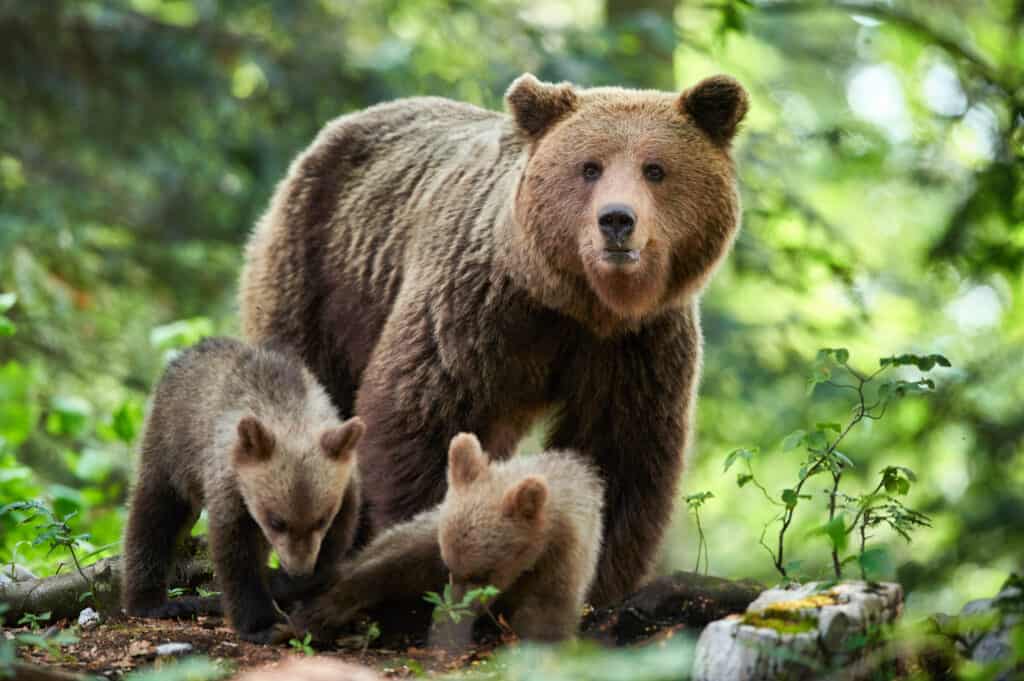
Female brown bears only reproduce once ever three years.
©Piotr Krzeslak/Shutterstock.com
Population
It is thought that there are now approximately 190,000 brown bears left in the world. They are the largest living carnivores, although often thought of as omnivores, and have a high priority on the conservation list.
Within the United States, in Glacier and Yellowstone National Parks, you can see brown bears. Those are the only places in the country where they live. However, there is an effort, through brown bear reintroduction programs, to bring this bear back.
Russia has the highest number of brown bears, with a population of 100,000. The Carpathian Mountains have a large population; countries include Slovakia, Poland, Ukraine, and Romania. Other places that have brown bear populations include Palestine, eastern Siberia, and the Himalayan region. They are also in the Atlas Mountains of northwest Africa and on Hokkaido, an island in northern Japan.
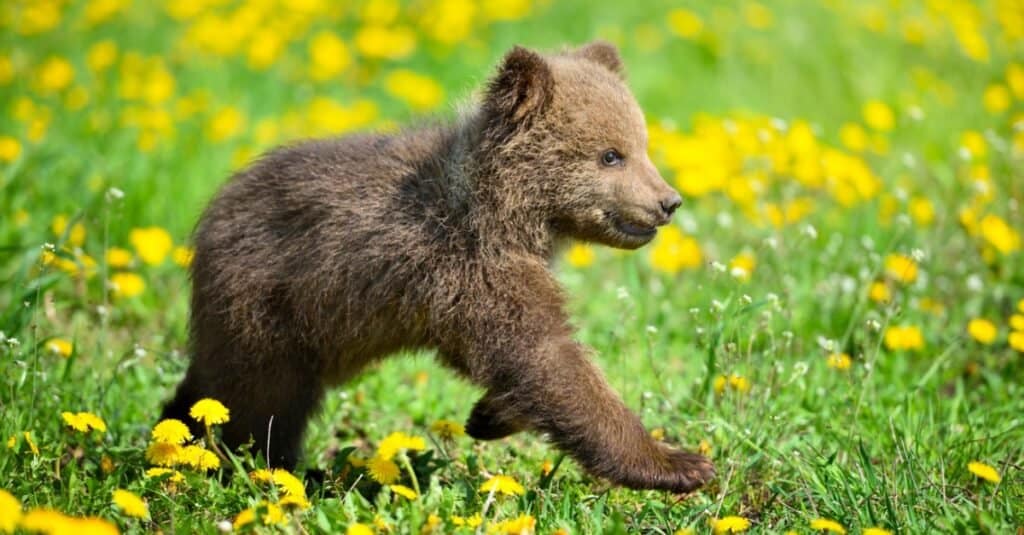
There are approximately 190,000 brown bears left in the world.
©iStock.com/Nataliia_Melnychuk
5 Brown Bear Paw Facts
- The brown bear has four large paws, and each of the paws of the brown bear has five toes that result in long claws.
- The two front paws of the brown bear have toes that have longer claws than the back paws, as the brown bear uses its front paws for digging.
- The two back paws of the brown bear are larger than the two front paws as the brown bear often stands on its hind legs to either survey its surroundings or to get food out of higher places.
- The brown bear uses its front paws with their enormous claws to rip open logs that have bugs inside so that it can eat them.
- The brown bear uses its specially structured paws and legs in order to help it run fast, climb trees and swim well.
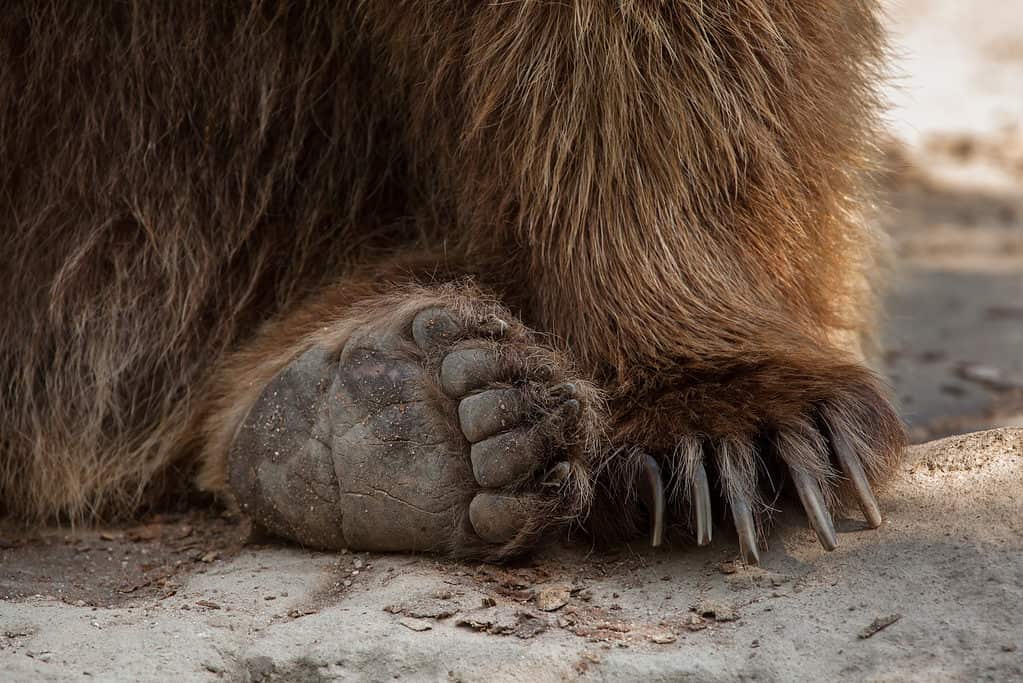
The two front paws of the brown bear have toes that have longer claws than the back paws, as the brown bear uses its front paws for digging.
©Vladimir Wrangel/Shutterstock.com
5 Brown Bear Teeth Facts
- Brown bears do not normally bite their prey but instead grind and crunch with their enormous teeth to get their meal into them.
- The brown bear has approximately 42 teeth, including large predatory teeth that the brown bear uses to shred meat and skin.
- The brown bear uses both its large, strong paws and its sharp teeth to catch and kill its prey and will either bite the neck of the animal or swipe it with its immense forearms.
- The molar teeth of the brown bear increase in size as they go further into the mouth of the brown bear, and the brown bear predominantly uses its largest molar to grind up tough food.
- The size of the teeth of the brown bear is dependent on the size of the bear itself, so bigger bears will have bigger teeth than smaller bears.
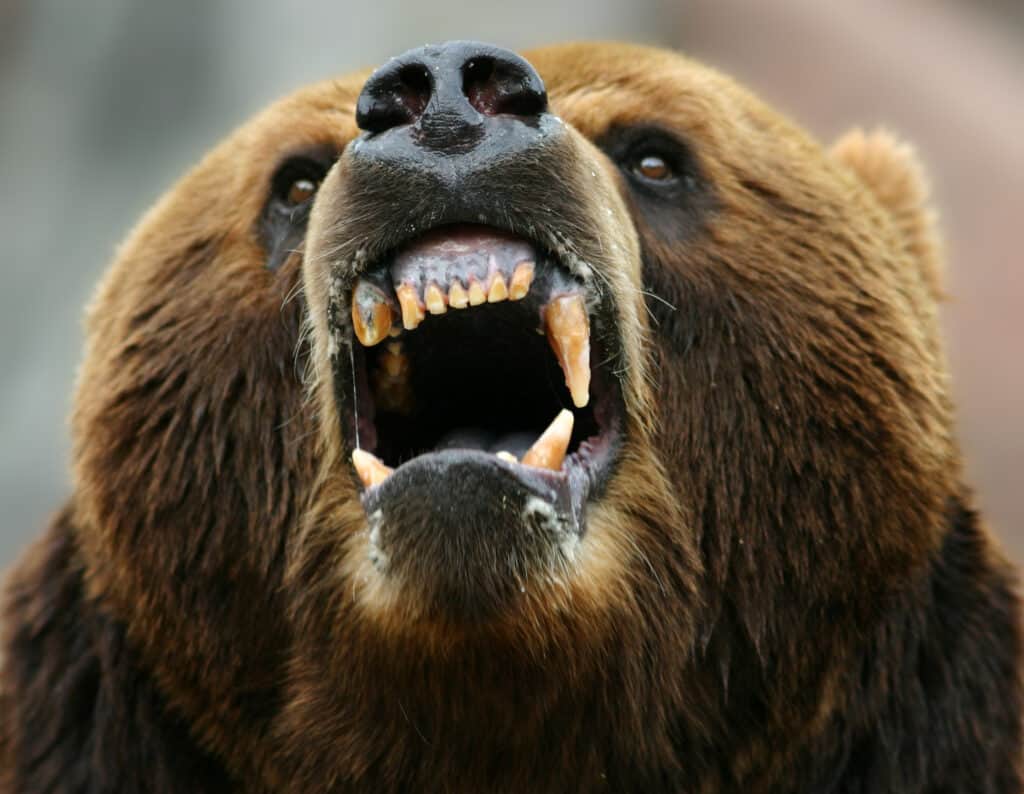
Brown bears do not normally bite their prey but instead grind and crunch with their enormous teeth.
©PhotoBarmaley/Shutterstock.com
16 Types of Brown Bear
- Grizzly bear – Ursus arctos horribilis. Also known as the North American brown bear. 290-600 pounds. 3.5 feet tall.
- Kodiak bear – Ursus arctos middendorffi. Also known as the Alaskan brown bear. Lives on the Kodiak Archipelago in Alaska. Weigh up to 1,500 pounds.
- Eurasian brown bear – Ursus arctos arctos. Also called the European brown bear. Lives throughout Eurasia. Weighs 330-780 pounds.
- Marsican brown bear – Ursus arctos marsicanus. Also known as the Apennine brown bear. Critically endangered species. Males are over 6 feet tall.
- Ussuri brown bear – Ursus arctos lasiotus. Also known as Ezo brown bear, Russian grizzly, and black grizzly. Weigh 880-1200 pounds.
- Alaska Peninsula brown bear – Ursus arctos gyas. Also called peninsular grizzly. Lives on the coast of Alaska. Weighs 800-1200 pounds.
- Himalayan brown bear – Ursus arctos isabellinus. Also known as the Himalayan red bear. Weighs 400-880 pounds.
- Syrian brown bear – Ursus arctos syriacus. Native to the middle east.
- Kamchatka brown bear – Ursus arctos beringianus. Also called the Far Eastern brown bear. Largest brown bear in Eurasia, weighing up to 1430 pounds and up to 9.8 feet long.
- Eastern Siberian brown bear – Ursus arctos collaris. Weighs 300-550 pounds.
- Gobi bear – Ursus arctos gobiensis. Called Mazaalai in Mongolia. Critically endangered species.
- Tibetan bear – Ursus arctos pruinosus. Also called the Tibetan blue bear. Very rare to spot one, as there are only 5,000 left in the wild.
- Cantabrian brown bear – Ursus arctos pyrenaicus. The largest animal on the Iberian Peninsula. Weigh 203-397 pounds. Various shades of brown and cream.
- Dall Island brown bear – Ursus arctos dalli. Some scientists believe this bear to be a variation of other North American brown bears. DNA analysis is needed.
- ABC Islands bear – Ursus arctos sitkensis. Also called the Sitka brown bear. Very dark-colored fur.
- Stickeen brown bear – Ursus arctos stikeenensis. Lives in British Columbia near the Stikine River.
5 Extinct Brown Bears
- California grizzly bear – Ursus arctos californicus. Now extinct.
- Atlas bear – Ursus arctos crowtheri
- Steppe brown bear – Ursus arctos priscus
- Mexican grizzly bear – Ursus arctos nelsoni
- Ungava brown bear – Ursus arctos ungavaesis.
Brown Bear FAQs (Frequently Asked Questions)
Are Brown Bears herbivores, carnivores, or omnivores?
Brown Bears are Omnivores, meaning they eat both plants and other animals.
What Kingdom do Brown Bears belong to?
Brown Bears belong to the Kingdom Animalia.
What phylum do Brown Bears belong to?
Brown Bears belong to the phylum Chordata.
What class do Brown Bears belong to?
Brown Bears belong to the class Mammalia.
What family do Brown Bears belong to?
Brown Bears belong to the family Ursidae.
What order do Brown Bears belong to?
Brown Bears belong to the order Carnivora.
What genus do Brown Bears belong to?
Brown Bears belong to the genus Ursus.
What type of covering do Brown Bears have?
Brown Bears are covered in Fur.
In what type of habitat do Brown Bears live?
Brown Bears live in forests and mountainous regions.
What is the main prey for Brown Bears?
Brown Bears prey on fish, fruit, and insects.
What are some predators of Brown Bears?
Predators of Brown Bears include humans, wolves, and cougars.
What are some distinguishing features of Brown Bears?
Brown Bears have powerful forearms and hibernate in the winter.
How many babies do Brown Bears have?
The average number of babies a Brown Bear has is 3.
What is an interesting fact about Brown Bears?
Brown Bears are a dominant predator in their environment!
What is the scientific name for the Brown Bear?
The scientific name for the Brown Bear is Ursus Arctos.
What is the lifespan of a Brown Bear?
Brown Bears can live for 20 to 30 years.
How fast is a Brown Bear?
A Brown Bear can travel at speeds of up to 35 miles per hour.
How large can a brown bear get?
Kodiak bears are the largest subspecies of brown bear. The largest Kodiak bear ever recorded was a captive bear named Clyde. He lived at the Dakota Zoo in Bismarck, North Dakota and weighed in at an impressive 2130 lbs!
How to say Brown Bear in ...
Thank you for reading! Have some feedback for us? Contact the AZ Animals editorial team.
Sources
- David Burnie, Dorling Kindersley (2011) Animal, The Definitive Visual Guide To The World's Wildlife
- Tom Jackson, Lorenz Books (2007) The World Encyclopedia Of Animals
- David Burnie, Kingfisher (2011) The Kingfisher Animal Encyclopedia
- Richard Mackay, University of California Press (2009) The Atlas Of Endangered Species
- David Burnie, Dorling Kindersley (2008) Illustrated Encyclopedia Of Animals
- Dorling Kindersley (2006) Dorling Kindersley Encyclopedia Of Animals
- David W. Macdonald, Oxford University Press (2010) The Encyclopedia Of Mammals

